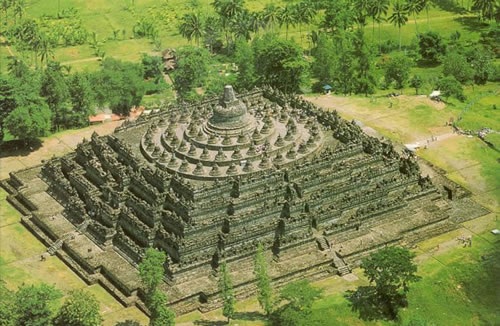At last we pull into the parking lot for Borobudur, the largest Buddhist temple in the whole world! Vendors galore surround us. We push our way through them, saying we don't want to buy anything right now. One of our women tells a woman vendor her name. The woman says she'll remember it! Some, especially the children, very persistently follow us almost all the way along the lengthy entrance road.
Suddenly, through a break in the trees, we see the upper ramparts of the temple. Looking very much like a tiered castle tapering to a single tower in the center, it's quite an impressive sight. Even at this distance It's mind-boggling, and we can't even see the lower levels from here!

Borobudur, aerial view
When we arrive at the base of the temple, our guide finds a most welcome spot of shade. Now that we're this close to the temple, we can't see the top tiers that's we'd seen when we first viewed it! Our guide, who has a PhD in East Asian Politics and Religion, starts telling us about this temple. Quite knowledgeable, he outlines the various theories people have developed about the purpose for this temple. He explains his own theories where they differ from the "authorities." His theories "feel" better to me than those of the "experts."
Certain Buddhist priests and rulers built this temple long ago, not for worshipping, but to express in symbolic, concrete form the different levels of consciousness! Along the terraced walls of levels one through four are thousands of bas relief sculptures showing scenes from the lives of the saints and of the Buddha himself.
Our other Barbara, not the one in the wheelchair, is beside herself with excitement. She is the Asian curator of the Milwaukee Museum! She's done extensive book research on Borobudur, and now she gets to examine it in person. I decide to stick with her. She's hunting for three specific bas relief panels that depict three ships. These ships each have two masts. But according to all the "authorities" that Barbara has read, ships from the era when this temple was built had only ONE mast. All the authorities agree that two-masted ships date from more recent times. After diligent searching, we find all three ships! I snap their pictures and Barbara takes extensive notes.
I point my camera at many of the more interesting panels, too. Scenes of Buddha counseling with nobles, saints, animals, peasants, kings; scenes of mythical monsters and animal-gods; various conveyances loaded with people or goods; animals frolicking in the woods; houses and temples and worshippers; ad infinitum. I wish I could record them all, starting with the very first one, and then be able to have an expert interpret them for me! Wow! What a story book that would make!
Spaced along each wall of each of the four lower levels are "grottos" each containing a seated Buddha. Our guide explained the seven hand positions, each symbolizing a particular message from Buddha. His right hand is the one to watch--its position and the number of fingers held up are the key. Here our guide differs in interpretation from the experts, as he says there are only seven distinct positions; the experts claim there are eight. But our guide believes that the eighth position simply repeats the whole communication over again on a higher level. Here again, I think his explanation makes more sense than what the experts have concluded. Our guide seems to have more of a metaphysical understanding than the experts from other eras or even this modern era.
I attempt to photograph these seven hand positions. But the way the statues all face outward from the walls makes extreme angles for shooting, and therefore, distortions. Also, will my flash open up the shadows from the distance I have to shoot?
Having explored the bas relief levels, we now climb steep stone steps to the first level that represents a higher state of consciousness. No more elaborate ornamentation here. Only stark stone walls and 36 stupas--bell-shaped stone chambers each containing a seated larger-than-life-sized Buddha. One stupa has its stone, woven latice-work removed, exposing the Buddha within. Here again, photographing this Buddha is difficult. He is facing outward. I feel like I'm teetering on the brink of the stone wall. I'm not quite as brave--foolhardy(?)--as some of the tourists--I just lean as far as I can.
The next level up, the fifth, has 24 stupas. The sixth level up has 16, but the seventh one has only four. The final and highest level, representing the ultimate achievement in higher consciousness, consists of one huge empty stupa.
Scholars have determined that no Buddha was ever installed here. They explain this omission by saying the builders ran out of time or money, or both. Our guide, however, feels this stupa was left empty deliberately: at this highest level of consciousness, no separation between finite man and infinite God exists. All is unmanifest Oneness, wholeness. Again, I feel our guide understands far better than the so-called experts.
For more information on the history of Borobudur and some beautiful photos, this webpage offers visual treats.
Go to Page 15
1 ~ 2 ~ 3 ~ 4 ~ 5 ~ 6 ~ 7 ~ 8 ~ 9 ~ 10 ~ 11
12 ~ 13 ~ 14 ~ 15 ~ 16 ~ 17 ~ 18 ~ 19
Tone By Tone Dot Net
|